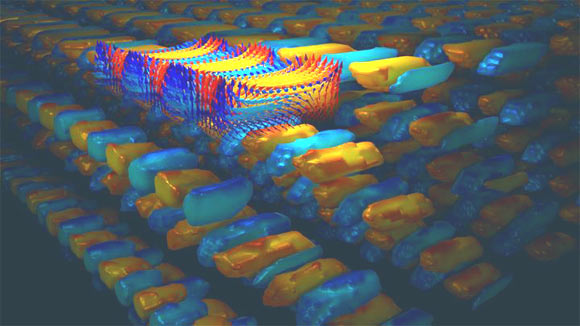Stimulation with ultrafast light pulses can realize and manipulate states of matter with emergent structural, electronic and magnetic phenomena. According to a new study, published in the journal Nature Materials, an ultrafast laser pulse plus ‘frustration’ resulted in a new state of matter — a ‘supercrystal.’
Source: Sci News
“We are looking for hidden states of matter by taking the matter out of its comfortable state, which we call the ground state,” said Pennsylvania State University’s Professor Venkatraman Gopalan, co-lead author of the study.
“We do this by exciting the electrons into a higher state using a photon, and then watching as the material falls back to its normal state. The idea is that in the excited state, or in a state it passes through for the blink of an eye on the way to the ground state, we will find properties that we would desire to have, such as new forms of polar, magnetic and electronic states.”
Finding these states is done by a pump-probe technique when a laser fires a photon at the sample for 100 femtoseconds at a wavelength of 400 nm (blue light).
The pump light excites the electrons into a higher energy state and is quickly followed by a probe light, which is a gentler pulse of light that reads the state of the material.
The challenge for Professor Gopalan and co-authors was to find a way to maintain the intermediate state of matter, because the state may exist for only some tiny fraction of a second and then disappear. However, the researchers discovered that, at room temperature, the supercrystal is stuck in that state essentially forever.
They accomplished this by ‘frustrating’ the system — not allowing the material to do what it wants to do, which is to allow it to minimize its energy fully without constraints.
The scientists did this by using single atomic layers of two materials, lead titanate and strontium titanate, stacked in alternating layers on top of each other to build up a 3D structure.
Lead titanate is a ferroelectric, a polar material that has electrical polarization leading to positive and negative electric poles in the material. Strontium titanate is not a ferroelectric material. This mismatch forced the electric polarization vectors to take an unnatural path, curving back on themselves to make vortices, like water swirling down a drain.
The team grew these layers on top of a crystal substrate whose crystals were intermediate in size between the two layered materials. This provided a second level of frustration, as the strontium titanate layer tried to stretch to conform with the crystal structure of the substrate, and the lead titanate had to compress to conform to it. This put the whole system into a delicate but frustrated state with multiple phases randomly distributed in the volume.
At this point, the researchers zapped the material with a laser pulse, which dumps free charges in the material, adding extra electrical energy to the system, driving it into a supercrystal.
These supercrystals have a unit cell — the simplest repeating unit in a crystal — much larger than any ordinary inorganic crystal, with a volume one million times larger than the unit cells of the original two materials. The material finds this state on its own.
Unlike transient states, this supercrystal state stays around potentially forever at room temperature — at least a year in this study — unless it is heated to about 350 degrees Fahrenheit (177 degrees Celsius) where it is erased.
The process can be repeated by hitting the material with a light pulse and erased using heat. This state can only be created by ultrashort laser pulses with a certain minimum amount of threshold energy, and not by spreading out that energy over long pulses.
The scientists also used high energy X-ray diffraction to examine the supercrystal before and after it forms, clearly showing the transformation from disordered matter into a supercrystal.
“By virtue of its short pulse duration, an ultrafast laser imprints excitations in materials faster than their intrinsic response time,” said study first author Dr. Vlad Stoica, a postdoctoral researcher at Pennsylvania State University and Argonne National Laboratory.
“While such dynamical transformations were already explored for decades to stimulate the ordering of materials, a strategy for their steady state stabilization seemed out of reach until now.”

































Leave a Comment
You must be logged in to post a comment.